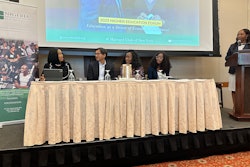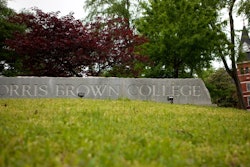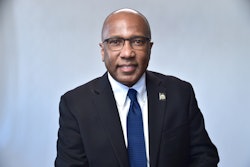Spending on Sevis
New system to track international student enrollment leaves educators stressed, while the federal government reports its success
By Kendra Hamilton
It’s been a bruising year for everyone involved with international education. And no one in the community of international educators can yet breathe a sigh of relief, because soon colleges and universities, trade schools, certificate programs and even high-school exchange programs will face a critical milestone.
Thirty days after their (student) enrollment periods end, “Every single (school with an international enrollment) will be reporting on every single student in the same relative time frame,” says Ursula Oaks, spokeswoman for NAFSA: Association of International Educators. With a total of over half a million international students enrolled at postsecondary institutions and over a million international and exchange students in the United States, “It’ll be quite a data load to the SEVIS system.”
What is the SEVIS system and why is it causing such stress? In the alphabet soup of educational acronyms, this is one whose importance has been looming larger than ever since the Sept. 11 terrorist attacks.
The Student and Exchange Visitor Information System or SEVIS is an Internet-based program which the now-defunct Immigration and Naturalization Service put in place to monitor the movements and enrollment status of international students in the United States. And according to international educators, it’s changing the face of the field.
“The profession can’t function any longer without the technology component, and that means hiring people with technical skills,” says Peter Briggs, director of the Office of International Students and Scholars at Michigan State University. “Some people are actually choosing to leave the profession because they don’t want to make the adjustment.
“We’re no longer spending our time doing the sorts of things, using the kinds of intercultural competencies, that drew them into the field,” Briggs adds. “How do we spend our time these days in international education? Mostly we spend our time on SEVIS.”
In Washington, D.C., the city with the fourth largest concentration of international students in the nation, “Our office has been putting in umpteen hours of manpower,” says Dr. Grace Ansah, director of international student services at Howard University.
At the University of Southern California, the school with the largest international student enrollment in the nation, top administrators like the deputy chief information officer of the university, the vice president of student affairs, the director of the office of international students and scholars, and leading admissions officials “sat around a table and banged through the issues week after week after week,” says Dr. Michael Thompson, vice provost for enrollment and dean of admissions and financial aid.
Similar stories can be told at every school with a significant international population and many of those with smaller populations. However, the view from Immigration and Customs Enforcement (ICE), the division of Homeland Security formerly known as the INS, is that “SEVIS is going great. Even though there has been all the criticism” in the media and from schools experiencing problems with their implementation, “from our side, it’s been very successful,” says Garrison Courtney, ICE spokesman.
“We have over a million students in the SEVIS database so far. We usually see a million students annually, so we’re about right where we should be,” Courtney explains.
And despite gloomy predictions that the specter of Big Brother would keep international students away from U.S. shores, there’s been a jump in visa applications. “The State Department has approved 233,000 new students for this year, so that’s a substantial increase,” Courtney says.
But the view from the trenches is less sanguine.
“Frankly,” says USC’s Thompson, “this has been enormously challenging, with the government giving us deadlines to implement but not providing either the procedures or the software in a timely way for us to do the things we needed to do.”
The Birth of SEVIS
In tracing its roots, the concept of an automated system for monitoring international exchange students and improving information flow between the schools and the federal government has been in the works for just over a decade, Courtney says. The testing of a prototype began with 20 pilot schools in the mid-1990s, but after Sept. 11, however, the Patriot Act mandated a significant expansion of the tracking program and set Jan. 30, 2003, as the date for full implementation.
In practice, this meant that schools had to produce student visa petitions, called I-20s, both for all international students enrolled in U.S. institutions and, in a significant change, for all their spouses and dependents, too.
“We were collecting data we’d never had to collect before,” Ansah says. “It added up to 150 additional demographic fields of information that we did not collect previously.”
At the same time as the I-20s were being generated, each student’s information had to be entered into the SEVIS system. Once they were entered, there was a series of strict deadlines by which schools were required to update the files with information on such issues as failure to enroll, dropping below the required number of program credits, changes in majors, changes in dependents, extensions of stay and much more.
Groups such as the American Council on Education (ACE) warned that the deadline was too tight. The argument was that SEVIS was more than just a new data system. It represented, in fact, a major change in relationships and information flow among admissions offices, international offices and IT departments.
Exacerbating those issues were delays on the government’s end. As late as June 2002, according to ACE, the system was not ready to begin accepting batch processing, a fact that boded ill both for the schools developing custom programs and for vendors hoping to test the software, training and support programs they were planning to market to schools.
Eventually, the deadlines were pushed back, Courtney says. Schools were given two additional weeks, until Feb. 15, to become certified as SEVIS users. And the deadline by which students enrolled in the spring had to be entered into the SEVIS system was pushed back to Aug. 1.
But the spring rollout remained a stress-filled process for everyone involved.
Schools struggled with various technical glitches — from unsaved data to incorrect data showing up in the system. ICE faced mounting criticism of its efforts. Meanwhile, a communications problem between the SEVIS and Department of State systems was partially responsible for a visa backlog that grew so acute that the House Committee on Science held hearings on the problem in March.
Difficult as the situation was for the professionals, Thompson says, “The worst of the problems are actually experienced not by the government or the universities, but by the poor students and their families who are trying do the right thing.”
Among the serious incidents reported at congressional hearings and by NAFSA, the American Association of Collegiate Registrars and Admissions Officers and other agencies included:
l Four Princeton University students traveling abroad during their winter breaks had difficulty re-entering the country for spring semester. While a Chinese physics student was readmitted relatively quickly, three others — a Malaysian studying electrical engineering and two Chinese students in mechanical and civil engineering — missed a large chunk of the spring semester.
l A student from Thailand attending Southeastern University in Washington, D.C., was arrested by federal agents after SEVIS incorrectly listed her as having dropped out.
l A Belgian psychologist heading to Michigan State University on a postdoctoral fellowship had his passport taken by the U.S. Consulate in Brussels when his records could not be found in the SEVIS database.
l A student at the University of Colorado at Boulder was jailed for 48 hours because he was taking less than a full course load, even though he had his adviser’s permission.
Although the total number of the incidents appears to have been small relative to the total number of students in the system, they became part of a general “climate of uncertainty, apprehension, fear and discomfort” for students attempting to comply with the law, says Howard’s Ansah.
Michigan State’s Briggs adds, “I’ve really appreciated the maturity that our students have showed.” Though Michigan State students have had visa problems in Moscow, Brussels, Buenos Aires and many other consular offices around the world, “Most of the people that I talk to have said, ‘We’ve had terrorism for years. It’s new to the U.S. It’s not new to us.’ “
By July, some 5,937 schools had become SEVIS-certified. In an effort to make the Aug. 1 deadline move as smoothly as possible, ICE began staffing a “24-7” command center to coordinate problems with schools and serve as a liaison at ports of entry. In addition, because nearly 1,200 schools were still in a “pending certification” status, ICE has sent response teams to airports in Los Angeles, New York, Chicago, San Francisco, Miami, Detroit, Atlanta and Washington, D.C., to ensure that students from these schools could gain entry into the country.
Both steps have been viewed very positively by NAFSA’s membership, Oaks says.
But there are signs that international education has changed and perhaps for good.
Briggs notes that he recently fielded a call from the superintendent of the East Lansing (Mich.) schools, who had just found out that a school with an exchange program would have to become SEVIS-certified.
“Here’s an example of someone who perhaps didn’t use the exchange program very often who has now discovered he’s facing significant costs,” with software costs, training and so on. “My guess is you’ve dealt some people off the table in terms of their ability to participate.”
© Copyright 2005 by DiverseEducation.com





















